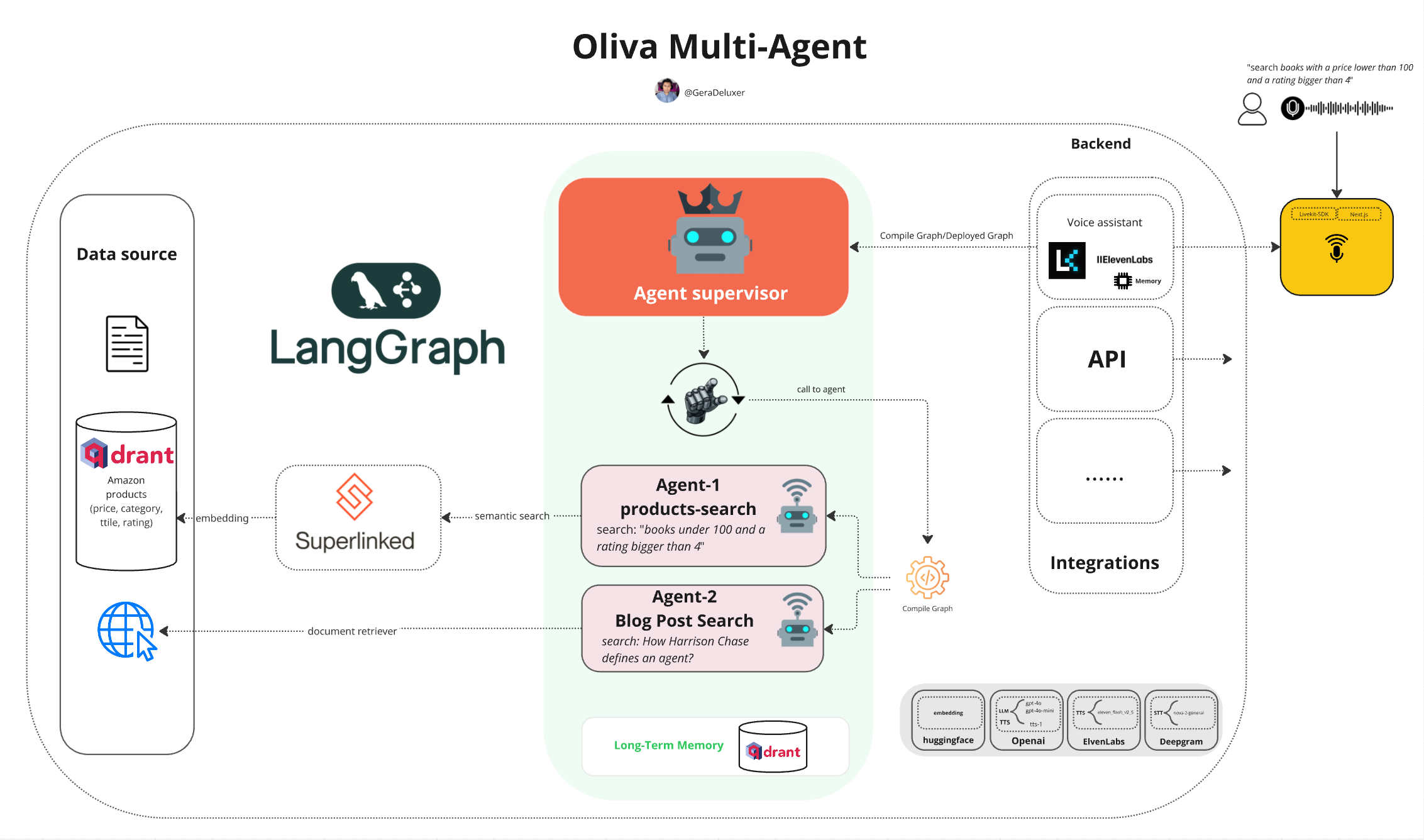What Is the Oliva Multi-Agent Supervisor?
GeraDeluxer
In a world where AI agents are rapidly reshaping how we interact with technology, Oliva enters the stage as a powerful, modular, and voice-enabled multi-agent assistant.
At the heart of this architecture lies something special: the Oliva Multi-Agent Supervisor — the decision-making brain that orchestrates multiple intelligent agents to carry out complex voice-initiated queries in real time.

🧠 What is the Multi-Agent Supervisor?
The Multi-Agent Supervisor in Oliva is a coordination layer built on top of LangGraph. Think of it like a conductor of an orchestra: it receives user requests, determines which agent is best suited to perform the task, and dynamically routes the query to the appropriate agent.
Here's how it works:
A user gives a voice command like:
“Search books with a price lower than 100 and a rating bigger than 4”The voice is processed using Deepgram (speech-to-text) and passed into Agent Supervisor.
The Agent Supervisor takes over, interpreting the intent and selecting the right agent (e.g.,
Agent-1: products-search).The selected agent performs a semantic search using Superlinked and Qdrant, retrieving relevant data (e.g., Amazon products).
The result is returned, and the assistant uses ElevenLabs/OpenAI to speak it back to the user.
🎯 Key role of the Supervisor:
The Supervisor maintains control of the workflow. It uses conditions, state management, and graph nodes (via LangGraph) to dynamically decide what the next step in the conversation or action should be.
🌐 Real-Time Voice Search with AI Agents
Oliva supports a natural voice interface using:
LiveKit for real-time voice communication.
Deepgram to convert speech into text.
ElevenLabs to convert results back into natural-sounding speech.
This seamless flow means users can interact with Oliva just like a real assistant — using only their voice.
🤖 Specialized Agents
You can also easily add as many agents as your use case requires. The architecture is designed to support 'n' agents, each with a specific task, custom prompt, tools and retrievers, the Supervisor handles routing between them seamlessly.
Agent-1: Products Search
Search for Amazon products stored in a Qdrant vector database, based on filters like:
Price
Rating
Category
Keywords
Example query: “Books under 100 and a rating bigger than 4.”
Agent-2: Blog Post Search
Retrieve knowledge from blog content — such as technical explanations or definitions — with advanced semantic understanding.
Example query: “How does Harrison Chase define an agent?”
🧱 Architecture Highlights
The Oliva project uses a modular architecture based on LangChain, with core components organized as follows:
Graph-based workflows (LangGraph)
Semantic search (Superlinked + Qdrant)
Voice assistant (LiveKit, Deepgram, ElevenLabs, Openai)
Multi-agent system with an intelligent supervisor
Long-term memory via embedded document storage (Qdrant)
📊 Agents are designed as nodes within a LangGraph, allowing flexible control flow, branching, and chaining of operations.
💡 Why This Matters
Oliva isn’t just another assistant. It’s:
Multi-modal (voice and text)
Multi-agent (task-specific workers)
Modular (easy to extend)
Open-source and built on cutting-edge LLM tools
By combining real-time voice processing with intelligent multi-agent routing, Oliva opens the door for conversational interfaces powered by structured reasoning — a huge step forward for assistant design.
🚀 Try It Yourself
You can get started with the project by cloning the repo here:
👉 https://github.com/Deluxer/oliva
Use it as a foundation to explore:
Agent routing strategies
LangGraph subgraph design
Voice-enabled semantic search
Final Thoughts
The Oliva Multi-Agent Supervisor shows how far we’ve come in making AI assistants smarter and more conversational. With its dynamic control over specialized agents, deep search capabilities, and voice interface — it's not just powerful, it's practical.
Whether you're building AI tools, researching multi-agent systems, or just curious about the future of assistants, Oliva is worth a closer look.